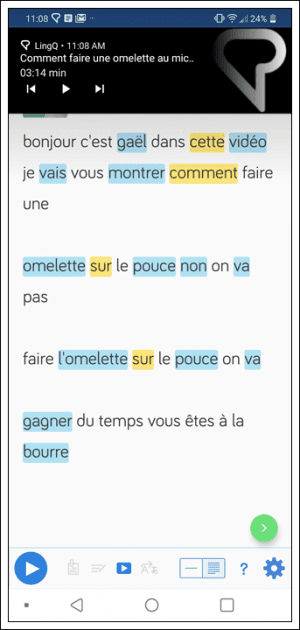In the Mood For the French Subjunctive
So, you’ve reached that stage in your French learning, where you’ve covered the key tenses, and now this thing called the French subjunctive keeps cropping up at every corner.
Most language teachers leave teaching the subjunctive for the very last minute, which actually means that for as long as their students remain unaware, their French will have been littered with mistakes, which the teacher has probably marked correctly, just because they haven’t covered that yet!

The fact of the matter is, you’ve probably come across examples of the subjunctive already at times, understood them, and maybe even reused those phrases, without realizing it was supposed to this really complicated thing.
While it’s only *occasionally* used in modern English…
If I were you/ him/ her/ them…
So be it!
… I am confident that with these tips, English speakers will easily see exactly where to slot the subjunctive into their speech and writing.
The French Subjunctive and a Change of Subject
The first place where we need to use the subjunctive is when using certain verbs and conjunctions in a sentence normally with (at least) two parts and a change of subject.
This is when the person who is the main focus of the sentence (who is on the receiving end of the action from the verb), changes to another person.
I’m afraid that she won’t come back.
The subject changes from I to she.
He wants you to be happy.
The subject changes from he to you.

Compare this to:
I want to be happy – Je veux être heureux.
No change of subject here, so the subjunctive isn’t required.
The most common verbs triggering the subjunctive are as follows:
vouloir que – to want that
désirer que – to wish that
aimer que – to like that
aimer mieux que – to like better, prefer that
préférer que – to prefer that
avoir peur que – to be afraid that
croire que – to believe that
regretter que – to be sorry that
être content que – to be pleased that
être surpris que – to be surprised that
Another place you will see the subjunctive is after impersonal expressions. This is because there is often the same emotion or desire conveyed.
Il faut que – it’s necessary that
Il vaut mieux que – it’s better that
Il est nécessaire que – it’s necessary that
Il est possible que – it’s possible that
Il est dommage que – it’s a shame that
A key word to keep in mind when learning the subjunctive tense is doubt. If there Is doubt implied, you should usually use the subjunctive tense.
How to Form the Subjunctive
-er and -re Verbs
All you need to know is -e -es -e -ions -iez and -ent.
Just like forming any of the other tenses, you start with the infinitive. For the subjunctive, remove the -er ending, then add the correct ending for je, tu, il, elle, on, nous, vous, ils or elles.
For -er verbs the endings are the same as for the present tense (most likely, the very first tense you will have covered), apart from the nous and vous forms, which have an extra i, like in the imperfect tense (which you usually cover before the subjunctive, too).
This means that you probably *have* been using the subjunctive already in some places, without even knowing it!
-ir Verbs
Just the same, but add:
-isse
-isses
-isse
-issions
-issiez
-issen
So to recap, there are two key triggers that show the subjunctive is required.
The first one, is where there is a change of subject.
Second, look out for the key verbs that require the subjunctive. The ones relating to hoping, wishing, desiring, wanting; or showing emotion and how you feel, fearing or expressing doubt or uncertainty.
You form the subjunctive with the same stem as in the present tense, and either the -er/-re or -ir endings.
The subjunctive does have several tenses but you are only likely to come across the present subjunctive.
Don’t be discouraged!
A lot of people are put off because often even a French native speaker can’t explain when or how to use the subjunctive, but I wouldn’t have a clue where to start explaining to someone some of the more complex aspects of English, and I imagine that’s the case for most people regarding their own, native language.
French people also often get mixed up between the future and conditional tenses, due to their barely audible differences, which are very much beginners’ level French, so don’t let yourself be put off getting to grips with the subjunctive!
Learn French Faster Using LingQ
Immersing yourself in French doesn’t require you to travel abroad or sign up for an expensive language program.
However, it can be a bit tiresome to find interesting content, go back and forth between sites, use different dictionaries to look up words, and so on.
That’s why there’s LingQ, the best way to learn French online because it lets you learn from content you enjoy! 
You can import videos, podcasts, and much more and turn them into interactive lessons.
Keep all your favorite French content stored in one place, easily look up new words, save vocabulary, and review. Check out our guide to importing content into LingQ for more information.
LingQ is available for desktop as well as Android and iOS. Gain access to thousands of hours of audio and transcripts and begin your journey to fluency today.
Learning French? Check out polyglot and LingQ cofounder Steve Kaufmann’s YouTube video on the difficulties of learning French and some tips for success!
***
Ella Louise Finn is a Freelance French & Spanish to Native English Translator, Proofreader, Copywriter and Transcriber, now based in Glasgow, Scotland, after spending time in Argentina and France honing her language skills.

